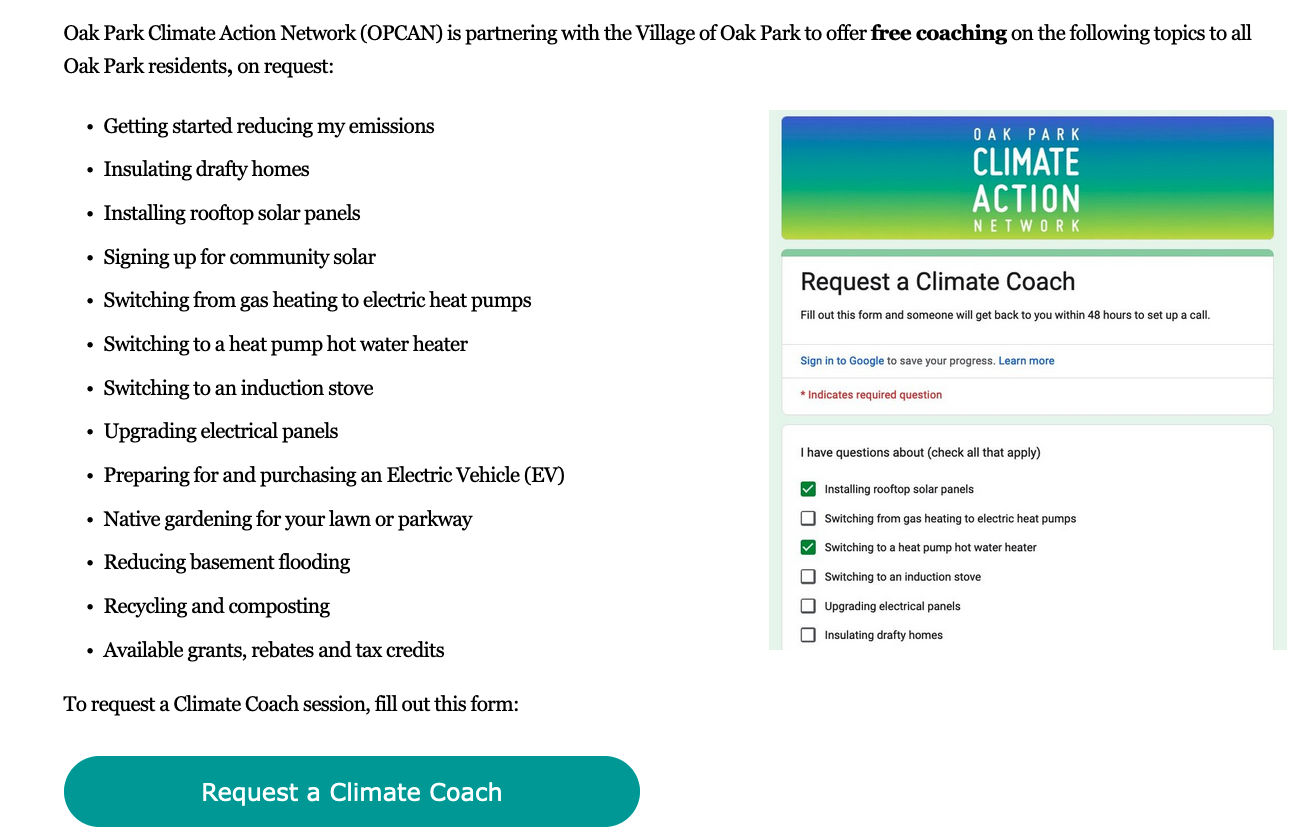Derek Eder
Civic Tech Builder

I use data, build tools, and organize people in Chicago to democratize power. Read more »
 DataMade
DataMade
Founder and Partner
 Village of Oak Park
Village of Oak Park
Trustee
 Chi Hack Night
Chi Hack Night
Co-Founder and President Emeritus
Wanna talk? Email me
Want to get my next post in your inbox? Sign up for email updates »
Electrifying Our Old Oak Park Home #4: One Year In
Published on Jun 29, 2024

Photos from Concerned about climate change, more Chicagoans are buying all-electric home heating systems, Chicago Tribune, Jan 24, 2024. Photos by John J. Kim / Chicago Tribune
This is Part 4 of my series Electrifying Our Old Oak Park Home. Read the rest here.
Update - April 2025: About a year after writing this, I learned about ComEd’s all-electric heat distribution rates, which lower our electricity bills by about 15%. With this factored in, our payback period is now between 10 and 15 years, a full year sooner!
A little over a year ago in April of 2023, we completed the electrification of our house. Since then, I’ve received a lot of interest in this project, was awarded a Green Award by the Village of Oak Park, and was even featured in the Chicago Tribune!
While the blog posts I’ve written have been useful to reference and point people to, there’s one outstanding question still to address: How much money are these electrification changes saving us, and how long until the upgrades pay for themselves?
Now that we’ve had a full year of using these systems, I have enough information to answer that question.
The short answer is: we are saving about $1,800 / year in utilities. Depending on where energy prices go in the next 20 years, we’ll recoup this cost between 10 and 15 years. Let’s dive into how I calculated that.
Table of contents
- $1,600 in utility savings for our first year
- Calculating the payback period
- Scenario 1: Assume energy prices stay stable
- Scenario 2: Assume natural gas prices increase
- How our electricity works now
- Wait, you have rooftop solar AND community solar?
- Other takeaways and lessons learned
- Questions? Ask a Climate Coach!
$1,600 in utility savings for our first year
I calculated the utility savings based on the costs of our electricity and natural gas usage of the year before we started this process (July 2021 – June 2022), compared to the costs we have paid since complete electrification (July 2023 – June 2024).
In 2025, we switched to ComEd’s all-electric heat distribution rates, which lower our electricity bills by about 15%.
Here’s a breakdown of those costs:
| Utility | July 2021 - June 2022 (gas and electric) |
July 2023 - June 2024 (fully electric) |
July 2023 - June 2024 (all-electric heat rate) |
| Electricity | $948.05 |
$820.09 |
$653.32 |
| Community solar | $569.19 |
$260.77 |
$260.77 |
| Natural Gas | $1,178.98 |
$0.00 |
$0.00 |
| Total | $2,696.22 |
$1,080.86 |
$914.09 |
We saved $1,615.36 in utilities between these two time periods. Not bad! With the all-electric heat rate, we are saving $1,782.13. Even better!
What’s especially great is that our natural gas bill is now zero, which is where our main savings is. But it’s also worth noting that our electricity bill is lower than it was before thanks to our solar panels, but not much lower because our electricity usage has increased — we’re using electricity now for heating, hot water, cooking, clothes drying and car charging (all previously powered by natural gas or gasoline).
Note: We paid less in community solar this year largely due to ComEd upgrading its billing system, which temporarily paused our community solar credits from being charged. Community solar gives us a 20% discount on electricity, so including this figure would likely improve our savings. More on why we still use community solar below.
Calculating the payback period
Using our annual savings in utilities, I was able to calculate how long it would take to pay off our electrification upgrades. From my previous post on electrification, the total cost, including rebates and tax credits was $46,202.
Our gas furnace, air conditioning, and hot water heater were all in need of replacement at the time of electrification, so not electrifying would have had a cost too. I did some research and got a few quotes, and I estimate it would have cost us about $18,000 to replace that equipment with conventional (non-electric) replacements.
Factoring that in, we need to calculate how long it would take for our net savings to total $28,202.00, the difference between our electric upgrades and what it would have cost us to just replace the old gas equipment.
How long that takes actually depends on what electricity and natural gas prices will be in the future. Predicting the future always involves making assumptions, so I decided to use two scenarios to get a range of possibilities.
Scenario 1: Assume energy prices stay stable
The US Energy Information Agency collects and analyzes data as it pertains to energy and the economy. Among the data they make available is an Annual Energy Outlook that projects out relatively stable energy production, consumption and prices through 2050.
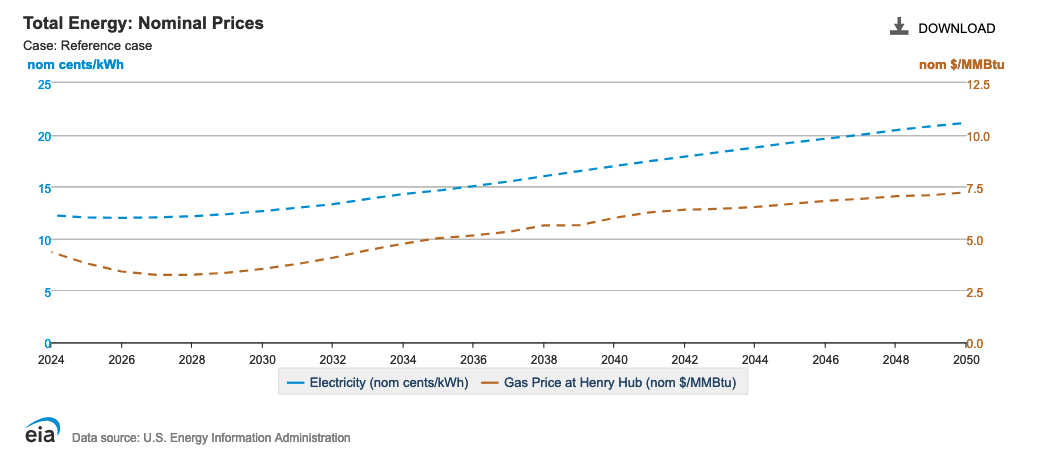
US EIA Annual Energy Outlook for Electricity (nom cents/kWh) vs Gas price at Henry Hub (nom $/MMBtu)
Using the change in these numbers I can calculate what we would spend on our all electric home (with the lower all-electric heating rate) vs what my bills would have been with no change (a mix of both gas and electric) and sum up the savings between the two.
Based on this projection, we’ll get our money back some time in 2039 (15 years) and continue to make money after that:
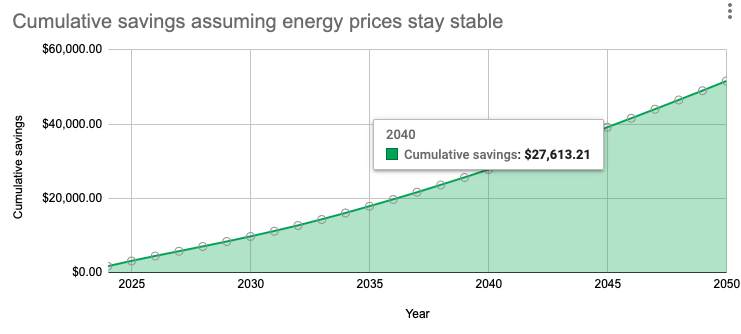
Cumulative savings per year assuming stable energy prices
Scenario 2: Assume natural gas prices increase
But that’s not the only way to calculate it! There are other projections out there that take in different factors. One of those projections is in the Future of Gas in Illinois by the Building Decarbonization Coalition. They looked at the infrastructure and investments of the 4 main gas utilities in Illinois and performed a cost modeling analysis to “assess the likely future levels of customer payments each utility will need in order to sustain its operations as customers depart the gas system at a pace in line with the decarbonization of Illinois’ building sector.”
In this report, which is bullish on a rapid clean energy transition, they predict natural gas prices will double for Nicor Gas (our utility) customers some time between 2032 and 2034.
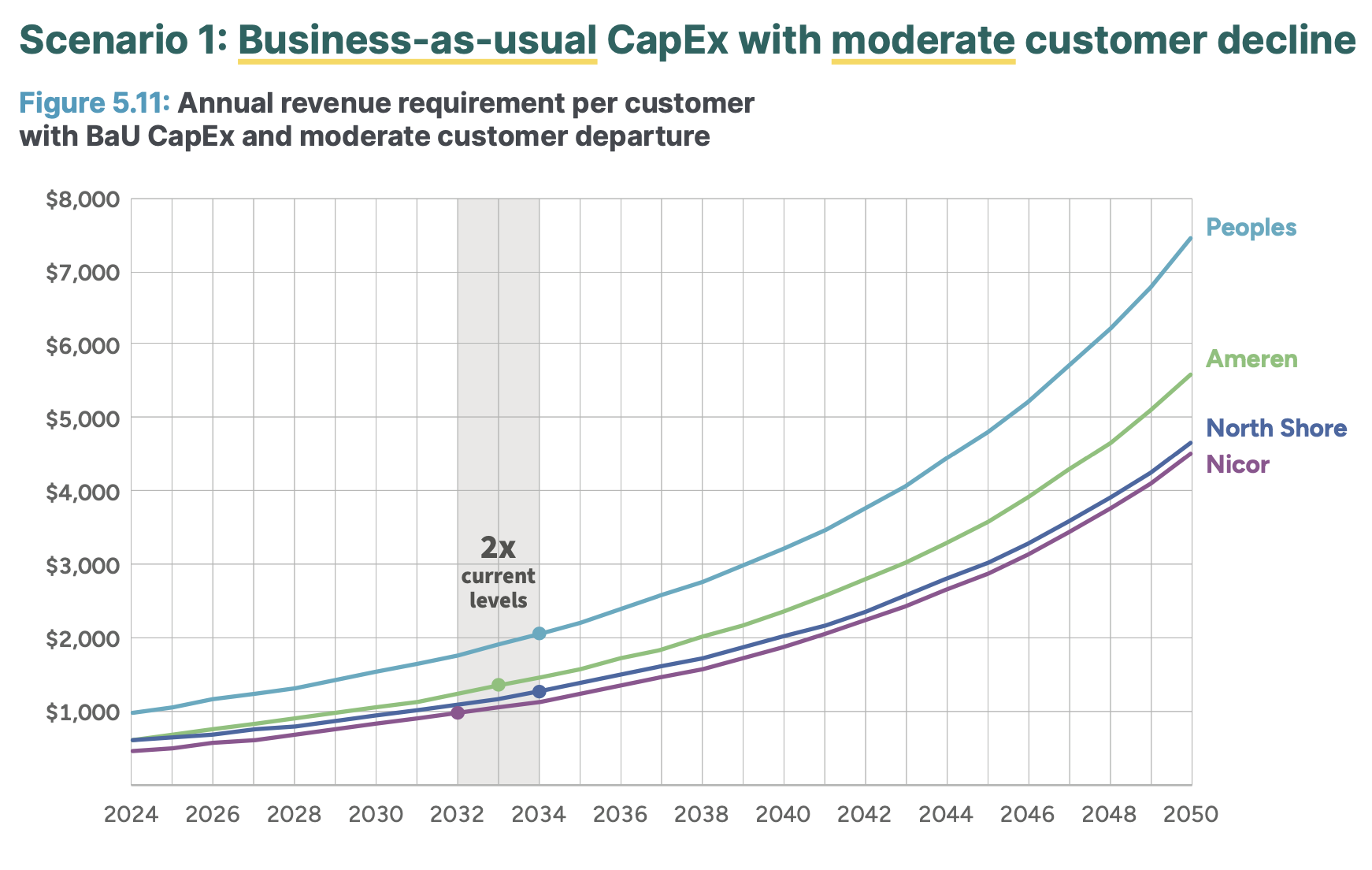
One of the many scenarios for natural gas prices from the Future of Gas in Illinois report
Using this scenario, with EIA’s electricity price projections, our savings increases much faster and we make our money back by 2034 (10 years) and continue to make a lot more money after that:
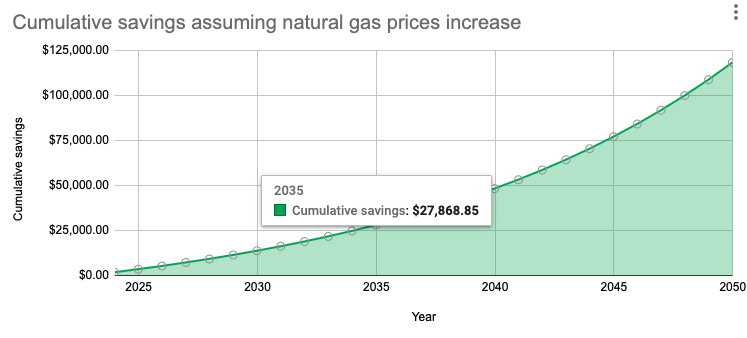
Cumulative savings per year assuming increasing natural gas prices
So which one is right? Obviously, we’d be better off if Scenario 2 happened. And although the Building Decarbonization Coalition is advocating for more building decarbonization and therefore may be biased, they did take into account more detailed factors in Illinois.
The EIA natural gas prices, on the other hand, come from Henry Hub based in Louisiana (reflecting a national average) and were calculated assuming natural gas use will remain stable while supply will increase.
In either scenario, our system will pay for itself before we need to replace our equipment, which makes this both a financial and a climate winner for us!
How our electricity works now
If you were curious, this is what our monthly bill looks like now:
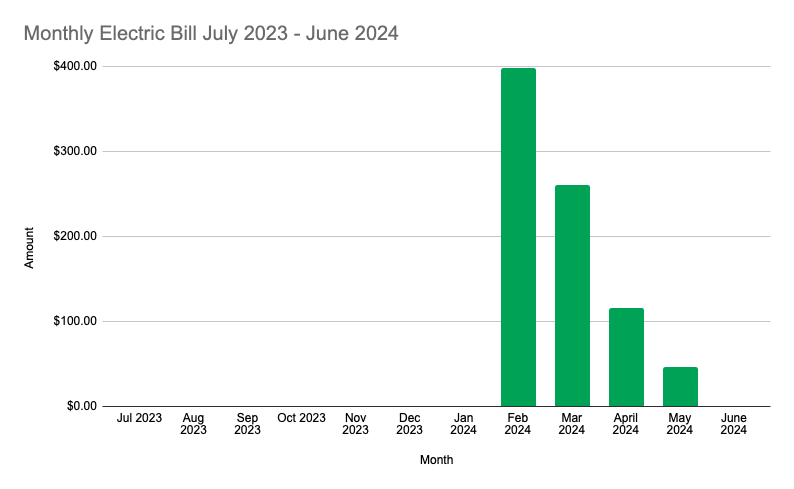
Our monthly ComEd bill for electricity from July 2023 thru June 2024
For 8 months out of the year, the bill is zero. This is due to our solar panels producing more electricity than we use during those months. Our solar production starts to taper off in October when the amount of sunlight decreases, which means we use our Net Metering credits (earned from extra production in summer). For us this year, the credits lasted us through January. In February, we got a big bill for heating when the temperatures dipped into the single digits. The bill started to decrease in March and April as it got warmer and we got more sunlight. By June, we will start banking credits again.
Here’s a look at it from the perspective of our solar panels:
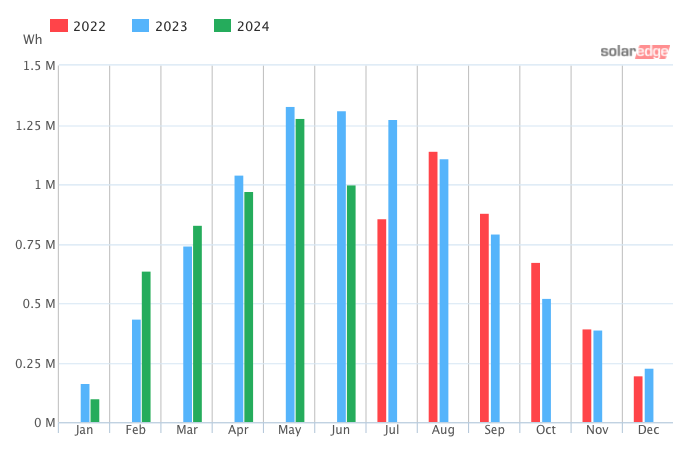
Our solar panel energy production for the past two years. Production peaks in May, June and July
Wait, you have rooftop solar AND community solar?
Yes, we do! We signed up for community solar in April 2021 before we got our rooftop solar panels. We went with MC Squared Energy Services and subscribed to 5.7 KW from Dukane Community Solar Farm. Every month, we pay for some of our electricity to come from this site at a 20% discount, and pay the rest we need to ComEd.
Even with our 8.7 KW rooftop solar, our electricity needs are more than we produce, so it’s worth it for us to continue subscribing to community solar.
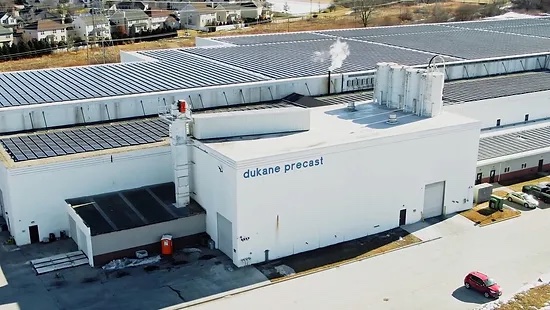
The Dukane Community Solar Farm on top of Dukane Precast in Aurora, IL
Other takeaways and lessons learned
-
Yes, heat pumps really do work in the winter! This is the number one thing both homeowners and HVAC contractors are most skeptical about. As we’ve lived through a Chicago winter, with a -13°F degree day in January, I can confirm that our heat pumps work, and we’ve stayed very comfortable in our 74°F home!
-
Home comfort is greatly improved: In fact, our home has never been more comfortable since insulating and switching to heat pumps. I am writing this blog post during a major midwest heatwave and our second floor, which used to get very hot in summer, is nice and cool now.
-
Electrification also increases your home value. It should also be noted that electrification improvements increase the value of our home, just like remodeling your kitchen or bathroom. That would mean, if we were to sell our home, we could get a higher price for it, potentially recouping most or all of these expenses. It could also mean that the assessed value of our home could go up, which would increase our property taxes in future years.
-
Make sure to inspect and service your equipment annually: This is advice that is good for anyone with a home, but it is worth noting that heat pumps are more complex than gas furnaces. Seriously, they have microchips in them. We’ve had a few service calls since installing to replace a broken temperature controller and address some fan rattling. Staying proactive is a great way to extend the life of your equipment.
-
ComEd’s all-electric heat rate is a huge boon: In 2025, we switched to ComEd’s all-electric heat distribution rates, which lower our electricity bills by about 15%. As of this writing, this is not something they advertise, but anyone with all-electric heat can request it, which I highly recommend you do.
-
Net metering for solar is amazing, BUT it is changing in IL in 2025: Net metering is what we use to bank extra solar credits in the summer for use in winter. In Illinois, we have a very favorable program — each unit of electricity you ‘sell’ to ComEd is ‘purchased’ back at the same price. Other states like Arizona and Florida pay you less and charge you more for your electricity. In 2025, the terms of Net Metering will change in Illinois, though the terms will still likely be very favorable.
-
Level 1 EV charging has been enough for us: We skipped installing a Level 2 EV charger in our garage to save money, and so far it’s been a great decision. We haven’t had any problems charging enough, and for road trips, we use PlugShare to find reliable high speed chargers.
-
We will not be buying batteries anytime soon: Batteries are still very expensive, and so far we’ve only had two 30-minute power outages since moving to this house 6 years ago. Power outages may become more common in the future and battery technology is also improving quickly, so it makes sense for us to wait for that purchase.
Questions? Ask a Climate Coach!
I hope these blog posts have been helpful. Because I’ve received a lot of questions from people who also want to do home electrification, I’ve helped set up a Climate Coaching service in Oak Park, which connects people who have questions about electrification (and other climate-related home renovations) to other local people who have completed the work, through advocacy group Oak Park Climate Action Network (OPCAN).
Request a Climate Coach on the OPCAN.org website!
Our website allows you to request a free 30-minute consultation with a climate coach (I’m one of them!), so you can ask any other burning questions you might have about electrification, native gardening, or any other climate-related property upgrade.
Special thanks to Aya O’Connor and Howard Kier for editing this post!
Want to get my next post in your inbox? Sign up for email updates »
Email signup • derek@derekeder.com • © 2026 Derek Eder
